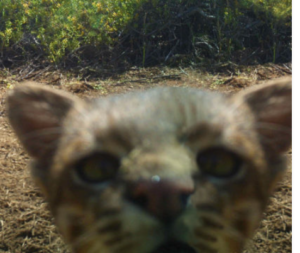
Since our inception in 1990, ISEC Canada has focused on sponsoring field research projects and education on small wild cats.
Where are the cats located? What kind of habitat do they use? What do they eat? What are their activity patterns and social organizations? Without all these answers, it is impossible to design an effective conservation plan. Without knowing how large the population is, or their preferred habitat, suitable protected areas cannot be determined.
Please note ISEC Canada does not hire any staff or volunteers for research projects.
Ongoing Funding
The Black-footed Cat Working Group (BFCWG) is part of a multidisciplinary effort in South Africa and Namibia to study the distribution, ecology, health, and reproduction of these tiny cats over an extended period. See our Black-footed Cat Project for details.
Starting in 2015, researchers have conducted a Pampas Cat research and conservation project. Ecology and Conservation of Pampas Cat in Northwestern Peru has three main components:
- Determine the home range, movement patterns, and habitat use of Pampas cats in the Sechura Desert
- Analyze the influence of free-ranging dogs in the activity patterns and abundance of Pampas cats in the tropical dry forest Peru
-
Conduct environmental education workshops in the Sechura Desert and tropical dry forest
Small Cat Action Fund
From 2012 to 2019, ISEC Canada formed a partnership with the Small Cat Action Fund of Panthera. Funds donated to ISEC by an anonymous donor were equally matched by Panthera, and went towards funding field research projects on small wild cats.
Projects Funded
- Ecology and conservation of Pampas cat (Leopardus colocola) in northwestern Peru, Alvaro Garcia-Olaechea, Cindy Hurtado
- Addressing conservation priorities of flat-headed cats and other sympatric cat species in the Lower Kinabatangan Wildlife Sanctuary, Borneo. Dr. Wai-Ming Wong, Dr. Marc Ancrenaz, Mr Eddie Ahmad
- Conservation Initiatives of fishing cat in the human dominated landscape of Eastern Nepal. Sagar Dahal and Deibya Raj Dahal
- Effects of human land-use on southern tigrina (Leopardus guttulus) populations. Flávia Pereira Tirelli
- Conservation of a newly recorded population of fishing cat (Prionailurus viverrinus) at a protected coastal mangrove area in south-west Cambodia. Vanessa Herranz Muñoz
- Evaluating the movement, interaction and adaptation to a big disturbance of three small spotted cats in a critical biological corridor in Costa Rica. Roberto Salom-Perez
- Sand cat (Felis margarita) in Kyzylkum Desert (South Kazakhstan). To assess sand cat current status, understand threats, and outline conservation plans. Georgiy Shakula
- Assessing the population status, ecology and conservation of caracal in the selected protected area of semi-arid habitat region of Rajasthan, India. Randeep Singh
- Compared ecology of three species of Neotropical cats (Leopardus tigrinus, L. geoffroyi and L. colocolo) in southern Brazil. Flavia Pereira Tirelli
- Searching for gold: are African golden cats persisting in Ghana? Nyeema Harris
- Effects of forest conversion, fragmentation and hunting on the status of Bornean Felids: Bay Cat, Flat-headed Cat, Marbled Cat. Anthony Giordano & Jedediah Brodie
- Ecology and conservation of the African golden cat in Uganda. David Mills
- Community based conservation of Himalayan lynx in Chitral, Pakistan. Jaffar Ud Din
- The relationship of toxicant exposure, genetic diversity and habitat fragmentation to disease susceptibility in Bobcats. Lauren Klein Serieys
- Halting retaliatory killing of a unique population of the most endangered felid of the Americas, the Andean Cat of Pategonia. Andres Novaro
- Population status of a poorly known small cat guild in the Argentine Espinal, Mauro Lucherini
- Conservation biology of the African golden cat: an assessment of habitat requirements, intra-guild competition and the impacts of human disturbance. Laila Bahaa-el-din
- Maximizing the contribution of carbon finance mechanisms to delivery biodiversity benefits to conservation. Ewan McDonald
- The Caracal Project – An innovative field study in South Africa that is proving caracals do not prefer domestic animals if their natural prey species are available
- Wild Cats of Brazil – a large scale multidisciplinary effort to study Brazilian felids.
- Spatial Ecology and Conservation of Felids – a long-term field study on the ecology of several rare and endangered cats in Thailand.
- Malaysia Carnivore Project – An international scientific team dedicated to the conservation of Asian carnivore species.
- The Global Cheetah Project – an ambitious count of cheetah populations and status throughout its African range.
- The Clouded Leopard Project – An initial survey in the Indian states of Mizoram and Sikkim to access the occurrence and status of the clouded leopard.
- The Alberta Cougar Project – this project was the longest running study of the cougar in North America, with data collected in the mountains of south western Alberta
- The East Kootenay Lynx Project – regional distribution, abundance and habitat association, spatial organization, dispersal and movement patterns of the lynx in the East Kootenay region of British Columbia

Venus Raval
Hi,
My self Venus Raval,
I am from Ahmedabad , India. I am Commerce student. Working as Business Development Executive. I am Doing rescue work since i was 10 years, and now need to know something that is there any one out in here who can help for the research and protection for small wild cats?
Eagerly Waiting for the Reply,
Best Regards,
Venus
Pat Bumstead
Most of the funded projects do not have websites, and their results are published in various scientific journals. I’ve added links to the Black-footed Cat Working Group, The Caracal Project and the Wild Cats of Brazil Project – thanks for the great idea.
Geoff
Can you provide links to these various projects if they have websites or to their completed research?
Pat Bumstead
Our funding supports research projects on the small wild cats only. Panthera.org has projects on jaguar and cougar, but I don’t believe they’re working in Mexico.
Agustin Rodriguez
Hello
Just a question, do you have right now some project in Mexico to protect the local felines as Jaguar or Cougar?
Thanks for your answer.
Agustin Rodriguez